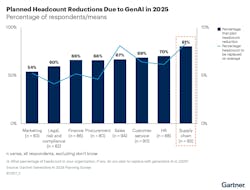A new survey from Gartner concludes that supply chain executives may be overly optimistic about the potential of generative AI (GenAI), and these misconceptions could have a negative impact on their talent strategies.
This is especially important to understand since 64% of supply chains are set to implement GenAI in some form this year.
Gartner’s research analyzed cross-functional survey data collected in November 2023 from 822 business executives outside of the IT function that were involved in their organization’s GenAI strategy, including 112 from the supply chain function. Gartner’s data showed that supply chain led all functions in terms of both the number of executives that indicated they planned headcount reductions and the total amount of planned headcount to be reduced by 2025 from the deployment of GenAI.
“GenAI should be an opportunity for CSCOs to make good on many of their talent aspirations, including freeing their teams up for higher value work and attracting top-tier technical talent,” said Sam Berndt, senior research director of Garnter's supply chain practice, in a statement. “However, our data shows that there is a real risk that many CSCOs will use GenAI to double down on poor assumptions that have already resulted in talent shortages, burnout and retention challenges for the function.”
Gartner’s analysis of the data identified three GenAI misconceptions that will soon negatively impact supply chain talent if CSCOs fail to make course corrections. The three misconceptions are:
Misconception 1: GenAI is primarily about labor cost savings and efficiency. An overemphasis on labor cost reductions risks not only being unrealistic, but also alienating the workforce as they see their prospects for long-term industry careers diminish. Instead of focusing primarily on cost reduction, CSCOs should emphasize GenAI’s ability to unlock new levels of productivity.
“Employees who receive access to GenAI tools quickly notice a broad range of benefits, from improved decision making to better skill development,” said Berndt. “GenAI then becomes supportive of retention, as it improves the employee experience, and the organization can reap the associated productivity benefits.”
Misconception 2: GenAI threatens early career employees. Supply chain leaders indicate that most of the headcount reduction would fall on early career employees. For a function that already struggles with attracting and recruiting new talent, this assumption will only make it more difficult to fill and maintain talent pipelines.
“Instead of viewing GenAI as a threat to entry level employees, CSCOs can advertise their use of the technology as an effective recruitment tool,” Berndt said. “GenAI use and accessibility can be a powerful recruitment tool for younger generations who view working with the technology as a job benefit.”
Misconception 3: GenAI is tangential to employees’ lives. Supply chain organizations have been slow to communicate how GenAI will impact the workforce. Without this communication, employees are filling the void with their own sources of information, speculation, and anxieties about future job security.
“Even a skeptical CSCO with minimal plans for GenAI should provide clear communications about the organization’s plans for the technology, and how it will affect the future of work,” said Berndt. “Employees are already forming conclusions about it that are almost certainly more negative than what CSCOs would want.”
While the ultimate evolution of how GenAI will shape supply chains is not fully known, CSCOs can take proactive steps to help shape the impact on their organizations. These leaders should do the following:
1. Start clear and regular communication with teams about GenAI and how the organization is exploring it.
2. Shape the GenAI conversation through experimentation, including identifying the use cases beyond chat bots that will ultimately require new roles and organizational structures to support them.
3. Treat GenAI as a future of work shift, not just a new technology. Use early enthusiasm about the technology to start building awareness around basic GenAI skills and behaviors (e.g. how to engineer and iterate prompts).




